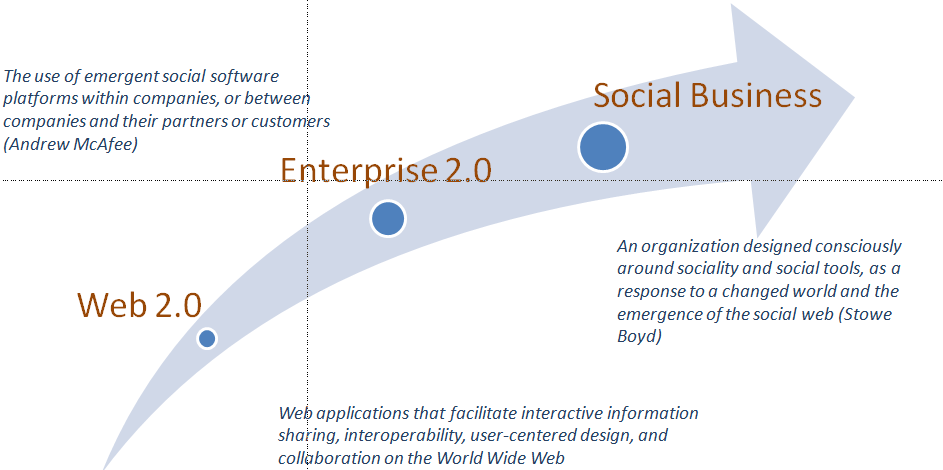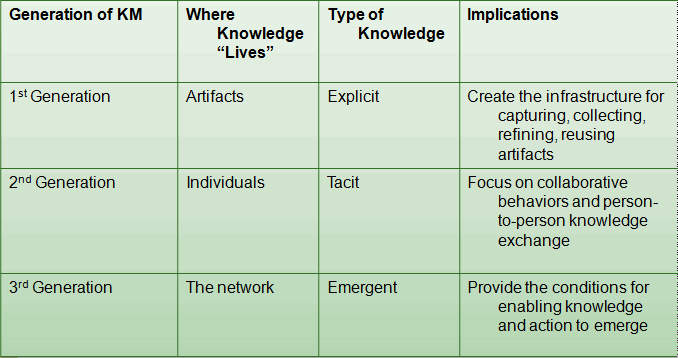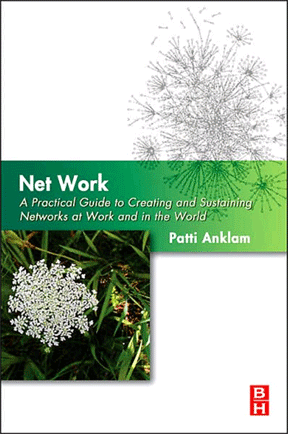#e2conf - Selling the Case
My posts over the next few days will be “live blogs” from the Enterprise 2.0 conference in Boston. Rumor has it already that 50% of attendees are practitioners. I take this to mean that we are well over the “chasm” in adoption and that the focus now is going to be on how to implement well. My personal listening for this conference includes:
- Leadership — not just issues about the management of IT in the context of enterprise 2.0, but what changes will be required of leaders in this interconnected world.
- Measuring effectiveness — one of my current client projects is focused on understanding what social media tools support organizational effectiveness in what ways.
- Related to #2, how to assist clients in selecting the right technology to meet their needs.
- How can companies build an intranet in such a way that it can grow from the inside out, that is design so that they can selectively open up content to outside partners as they evolve a knowledge base in the context of a social networking space
Sameer Patel and Oliver Marks of the Soros group have a session on “Selling the case for accelerating business performance with enterprise collaboration technologies.” They are up against the day-long “black-belt practitioners” workshop, so attendance is sparse. I’m hoping for insight into #2 above (Bolded text below indicate the sectionof the 3.25-hour workshop).
The Big Idea key question to be addressed is the “What’s in it for me?” Marks emphasizes that you have to be able to
- tell individuals how they will be able to get the work done that they are being paid for, when they currently think they are fine with email
- tell business unit managers how the shift will improve their business
- address the culture. Get your arms around how the company works now.
Marks recounts / neutron bomb / culture will come out the same
[Concurrently, @rappe links to a post by Sam Lawrence, "Social media isn't going anywhere. (What's it for?)" by which he means, it's here to stay, so let's get going on doing it right. (This is a key theme of this conference.) The session I am in address the ways that you need to talk to executives. This is part of what you need to get right.]
Marks and Patel continue with the key elements of Designing the Executive Pitch. They caution that you have to be careful not to position this as revolution (execs like to hear that others have already tried this stuff out). You can’t go in and tell execs that you are going to change the company’s DNA.
Assuming that you have a good idea of the Vendor Landscape, you will know which vendors to bring in.
[enter vendor panel] Panelists talk about how they sell to the C-suite, focusing on the business problems without talking about technology. Elevator pitches:
- Omar Divina from Socialtext: “You have the official org chart and you have the connective tissue of the informal organization. This software will help you make better connections across the
- Jordan Frank from Traction Software (doesn’t think that you can sell with an elevator system). “Most companies have systems that are designed to work when everything go right. Social software helps us to build systems that will work when things are not going right.
- Brian Stern from Newsgator: “I ask the question, ‘have you nailed your collaboration and communication needs within your company?’ “
Given questions about how to engage the IT department in the conversation during the initial sales cycle: A lot comes down to questions of “how does this app fit into my existing infrastructure” as IT people are not engaged with the “social stuff.” Some companies think they need to implement social social software but come to the table with a laundry list of features, but without
- passion for what social media can do
- understanding what business problems they want to solve
- use cases
Most successful use cases: twitter stream, central place for monitoring events, intranet collaboration.
One of the interesting questions/ surprises from conversations with customers (as per Jordan Frank): How are we going to apply six sigma to this? Though it strings one first as absurd to think about applying regimental continuous improvement, it is worth thinking about how a company could tune the implementation based on measurement of effectiveness. Jordan has been thinking about this lately, and blogged his thoughts on social process engineering yesterday.
It’s reassuring that vendors (at least these three, and I’m sure many more) are able to articulate the importance of deploying to customers who are ready and willing to work to make the implementation successful.
[exit vendors]
Sameer and Oliver continue a discussion of Getting Executives on Board. Without using the word “network,” they imply that it’s important to get people “outside the room” on board. That is, the E2.0 pitch might happen in a closed meeting to the decision-makers, but when they leave the room they’ll be calling colleagues to find out what they think. Understanding this informal network of influencers is important. (Of course, this applies to selling anything, not just E2.0)
Execution Planning includes requirements definition, mitigating risks, and addresses the issue of metrics. You have to establish metrics to gauge the success of the project — agree on metrics.
- Process performance. How well is a process executed today? What can we assume about what will be different?
- HR performance. Evaluating contributions of people as a gauge of “keepability” (my word)
- Communications performance. Teaching leaders to engage and communicate in new ways.
Launching the new environment is the topic of Bevin Hernandez of Penn State on the culture shift from “Me to We,” understands throing that every organization has (great phrase:) “a thousand points of ‘no’.” Her case study works through the steps from creating a core team, enrolling champions, launching a print media campaign with catchy postcards and getting started guides and thumb drives, putting the exec on YouTube, etc.
In transitioning the intranet, the Penn State outreach group re-branded their intranet portal from ”my.outreach” to “our.outreach.” A great example of using language to start to make a shift. She had more to say about language, but I’ll save that for tomorrow - she’s one of the morning keynoters.
Beyond launch is driving usage, always, and relentlessly. Social media isn’t going anywhere.




